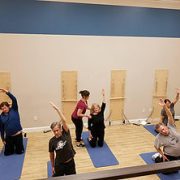Why Your Nagging Shoulder Blade Pain isn’t Going Away
The prevalence of shoulder pain tends to increase and become more severe as we age – especially for folks in their 50’s and beyond.
When people complain of shoulder pain – it can manifest in a lot of different ways. Sometimes pain appears in the front, sometimes on the very top of your shoulder, sometimes deep inside your joint… But probably the most annoying and uncomfortable type of shoulder pain I hear about is the one that occurs deep inside your shoulder blade.
It’s tough to get to, tough to pinpoint, and even harder to make go away.
It kind of feels like middle back pain – but also feels like shoulder pain – so which is it? And more importantly… Why isn’t it going away?
There are many reasons why we get shoulder pain and there’s a good explanation why it can move around and appear in so many places. It’s the most mobile joint in your body, which lends itself to lots of ways to get injured. And to add even more confusion – 47% of all shoulder pain originates from a source in your spine (neck) – even when you don’t have any neck pain.
Therefore, misdiagnosis of shoulder pain is very common and it’s probably the most common reason I see for that nagging shoulder blade pain not going away – no matter how many times you massage it, stretch it, or “theragun” it.
If you’ve had nagging shoulder blade pain for a while now and it’s not going away – there’s a really good chance it’s not actually a shoulder problem and you’ve been misdiagnosed.
Let’s look at a few key signs and considerations to help you figure out if that nagging pain in the middle of your shoulder blade has been misdiagnosed:
1. Location of your pain?
When your pain is coming from a source within your shoulder, the pain will be localized to your shoulder joint. “True” shoulder pain is typically felt directly in front of your shoulder, on top of your shoulder, or in a more involved shoulder problem (like a rotator cuff injury) you might feel some achiness down the side of your arm. But the pain will never radiate below your elbow. If the nagging pain in your shoulder blade ever causes pain past your elbow and into your forearm or hand, or radiates above your shoulder into your neck (the upper trap area) – odds are pretty good that you’re dealing with a spine problem and not a shoulder problem.
2. Do you experience numbness, tingling or burning?
If the nagging pain in your shoulder blade is ever associated with numbness, tingling, or burning – these are signs of nerve irritation, or perhaps nerve compression. If that’s happening – the problem is almost certainly coming from your neck. It’s very common for things like bulging discs to compress nerves, or limit movement, which can irritate nerves in your neck. The nerves in your neck will commonly refer symptoms into your upper shoulder/upper trap area, down your arm, and… you guessed it… right into the middle of your shoulder blade. And remember – you could be experiencing the referred symptoms without much (or any) pain in your neck. If you’ve got symptoms of numbness, burning, or tingling in your arm or shoulder along with nagging shoulder blade pain – and you haven’t yet gotten your neck examined by a mechanical pain specialist – there is a good chance you’ve been misdiagnosed.
3. Does posture affect your pain?
Do you notice that your shoulder blade pain changes depending on your posture? This is another tell tale sign that your shoulder blade pain is likely coming from your neck. Our heads are inclined to remain upright on top of our shoulders to look ahead at what’s in front of us. So when you slouch your middle back – your neck will always compensate so your head can look forward. Ever hear of the term “forward head posture”? That’s what we call the compensation your neck makes for curved, slouchy posture in your middle back. And in forward head posture, you will stretch out and eventually irritate the nerves in your lower neck. The nerves in your lower neck – particularly the areas of your C6 and C7 vertebrae – refer right into the middle of your shoulder blade. So if you notice the pain easing when you sit upright or lie down, and increasing with long car rides or sitting at a computer (when your back tends to be slouched) – there’s a very good chance the pain in your shoulder blade is coming from your neck.
The good news is that even if you’ve been misdiagnosed for some time, nagging pain in your shoulder blade is typically a mechanical problem and can be fixed naturally with a corrective movement prescription, postural training and education, and strengthening the areas around your neck and middle back. You don’t need to resort to injections or pain killers. Do me a favor though – don’t try and fix this problem yourself or by looking up exercises on YouTube. We call it a movement prescription for a reason – and it should be prescribed to you by a physical therapy specialist who has a deep understanding of the intricacies of mechanical pain and how it all works. If you want help finding someone like this in your area – get in touch – I’m happy to help.










